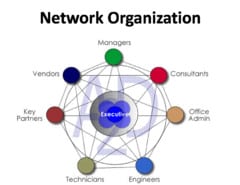A network structure is the one in which more than one organization combine to produce a good or provide a service.
These organizations can either get into a partnership for a particular venture, or one organization can hire others to handle one or more of its functions (outsourcing), for example, marketing, production, sales and so on.
Outsourcing is done by organizations pursuing network structure.
We also covered Functional Organizational Structure or Divisional Organizational Structure. if you’re interested to read about different types of organizational structures.
Table of Contents
Network Organizational Structure Examples
An organization that has been using network structure is H&M (Hennes & Mauritz), a very popular brand that has followers world over. H&M has outsourced the production and processing of their goods to different countries majorly Asian and South East Asian countries.
The figure above explains the fundamentals of a network organizational structure. In the middle, there is a blue circle with ‘core company’ written on it. A core company is a company that outsources or initiates the partnership in a network.
H&M is the core company in its case. As it can be seen, the core company distributes its functions to different companies which, in this case, are present in different countries: product development company in Australia, Call center company in New Zealand, the Accounting company in Australia, Distribution company in Singapore and Manufacturing company in Malaysia.
However, it is not at all binding to outsource work in different countries; companies do this usually to reduce costs. For example, to benefit from the cheap labor in China, companies move their production there.
Managers in the network structure play a vital role. They control the internal as well as external relationships. The network structure is less hierarchical; it is flatter because many layers of management are cut from between and their functions are passed on to other organizations.
This flat nature of network structure makes its span of control wider, leading to a possibility of a bottom to up communication. A network structure has its pros and cons.
Benefits of Network Structure
Clearer Focus
If a firm lets go all other functions except its own core competency, it can have a clearer focus on what it does the best. A network organizational structure allows doing so.
For example, if a firm specializes in clothes’ designing, it will not go in a hassle of manufacturing the fabric or stitching the clothes; it would just design clothes.
Chances of overall firm’s success are greater if the firm can utilize most or all of its time in doing what it does the best.
Lower Costs
Setting up a department and running it is much more expensive than outsourcing that function. Moreover, when a firm is setting up a functional department, there might also be many sunk costs which are not recovered.
Using network organizational structure, work can be outsourced to other firms which specialize in that particular work. This way, the firm will not only face lower costs but will also receive a better quality service than if it had done it itself.
Flexibility
Flexibility is one of the main reasons why firms pursue network organizational structure in the first place. By outsourcing work, an organization is in a flexible position. This allows them to change its production techniques, quantity, products’ designs or stop the production completely without facing any major problems.
On the other hand, if the firm owns all of the departments, it would be extremely difficult for it to change things. Changing things around will not only be costly but will create a hassle all around the organization.
Firms being responsive to changes in demand is also beneficial for customers. As they get what they want in a short span. Moreover, even the firm that performs a particular job for other firms will not be taking from their earnings. They will be getting work from other firms as well. So, it is a win-win situation for all.
Drawbacks of Network Structure
Control and Reliability
When a firm indulges in a network structure, it gets more spread out. As the network of an organization grows, it gets more and more difficult to control such a widespread network.
On top of that, some of the firm’s partners may be in other countries. This makes it more difficult to communicate and deliver things around. Moreover, some of the firms that delegate work, might not be reliable enough.
This delays in meeting the deadlines and commitments, so the entire system would suffer due to them.
Lack of secrecy
While pursuing a network organizational structure, when you outsource some work to another firm, that firm may also be doing work for your competitors. Your firm’s secret information may get leaked to your competitors by the firm working for you.
The reasons for information leaking might vary and can be bribed for information, leakage by accident, speculating about the work happening in the firm that’s working for you and so on.
Loss of control
When you outsource important work to external firms, you lose significant control over your operations. This way, you get dependent on the outside entities who can have a significant power over you, instead.
They can lag behind in work, stop meeting deadlines, start getting slow deliberately and deteriorate the quality. There can also arise a conflict of interest amongst internal and external entities. It is important to understand the entire process of conflict, and this conflict can hinder the system.
Sacrificing of profit
When you outsource work, you might also be sacrificing profit that you could have earned by yourself if you had done that outsourced work yourself. For example, if you manufacture your goods yourself instead of buying it from outside, there might be an increase in the potential profits of your firm.
The cost of outsourcing itself can be higher than if you do that work yourself.
Is a Network Structure Work It?
Network structure has its pros and cons, but weighing them, we can get on a stance that the benefits. This can help in outweighing the drawbacks and network structure. Firstly, if a firm can keep control over other firms that are being given the work responsibility.
Secondly, an agreement signing should take place so as to prevent a leak of any personal information. Moreover, it should be made sure that buying from outside, or outsourcing work is cheaper than doing that work yourself.
Work distribution takes place if the conditions are met.







